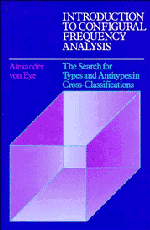 Introduction to Configural Frequency Analysis
Introduction to Configural Frequency Analysis Published online by Cambridge University Press: 04 August 2010
The following chapters introduce methods of longitudinal CFA. Simple longitudinal designs involve two observation points for one variable. In complex designs several variables are observed for several samples over many points in time. CFA enables one to analyze contingency tables displaying patterns of constancy and change in a unique way. Rather than identifying models of interrelationships among variables across time, CFA identifies cases with patterns that remain stable or show specific changes in behavior. CFA shows which patterns occur more often than expected by chance and what other patterns are very unlikely.
Longitudinal CFA deals with several types of change. For instance, systematic shifts in means may be described as trends, and systematic changes in variability may be described as examples of the “Law of Initial Values” (cf. Wall 1977). The following sections pay special attention to specifying the particular type of change under study, and to the model under which the expected frequencies are estimated.
Most of the models discussed in the above chapters assume independent samples. In longitudinal CFA, samples are no longer independent. Therefore, repeated observations cannot be analyzed with, for instance, k-sample CFA. This approach assumes the k samples to be independent. Treating repeated observations as independent would lead to an artificial increase of the sample size and, therefore, to grossly nonconservative statistical decisions. Thus, the following chapters present methods for the investigation of longitudinal data that avoid these problems.
To save this book to your Kindle, first ensure [email protected] is added to your Approved Personal Document E-mail List under your Personal Document Settings on the Manage Your Content and Devices page of your Amazon account. Then enter the ‘name’ part of your Kindle email address below. Find out more about saving to your Kindle.
Note you can select to save to either the @free.kindle.com or @kindle.com variations. ‘@free.kindle.com’ emails are free but can only be saved to your device when it is connected to wi-fi. ‘@kindle.com’ emails can be delivered even when you are not connected to wi-fi, but note that service fees apply.
Find out more about the Kindle Personal Document Service.
To save content items to your account, please confirm that you agree to abide by our usage policies. If this is the first time you use this feature, you will be asked to authorise Cambridge Core to connect with your account. Find out more about saving content to Dropbox.
To save content items to your account, please confirm that you agree to abide by our usage policies. If this is the first time you use this feature, you will be asked to authorise Cambridge Core to connect with your account. Find out more about saving content to Google Drive.